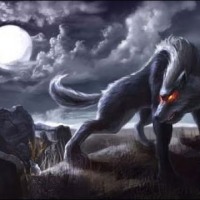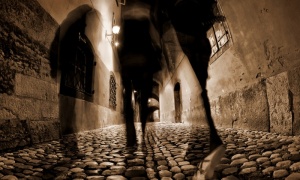Perhaps the most widely known and talked about modern American myth is that of the Mothman, a creature first documented in the late 1960s. Since then, the Mothman has been spotted countless times in the United States. Some say it’s a harbinger of cataclysmic events. Others say it’s an alien life form with connections to UFOs and Men in Black. Many thing it has a more practical explanation, is a hoax, or is the product of mass hysteria. Whatever the case, the Mothman continues to pop up in real life and pop culture and is one of the more intriguing examples of modern American folklore – something where a quick Google search can’t dissuage its origins; something that permeates the minds of the people inflicted and the communities that branch off of them; a thing that lingers and re-manifests, jostling memories of the first time it crept from the depths of nowhere and made itself known. As legend has it, on November 12, 1966, in Clendenin, West Virginia, a group of gravediggers working in a cemetery spotted something strange. They glanced up from their work as something huge soared over their heads. It was a massive figure that was moving rapidly from tree to tree. The gravediggers would later describe this figure as a “brown human being.” This was the first reported sighting of what would come to be known as the Mothman, an elusive creature that remains as mysterious as it was on the night that a few frightened witnesses first laid eyes on it. The Point Pleasant Mothman is a local legend that over the years has gained worldwide fame. Author John Keel popularized local folklore about the creature with his 1975 book The Mothman Prophecies. The book was later adapted into a 2002 feature film with the same title, starring Richard Gere. Some believe The Mothman is a bad omen , only appearing when catastrophe is about to strike. Whether the pictures are real or not, the benefits the legend of the Mothman brings to the town of Point Pleasant, it would seem, are very real.
Although the first Mothman sightings occurred near the small town of Point Pleasant, West Virginia in 1966, More and more reported sightings rolled in over the course of the next year. The first mention of him in a newspaper came in the Point Pleasant Register on November 16, 1966, with the headline: “Couples See Man-Sized Bird… Creature… Something.” Later an anonymous Ohio newspaper copy editor dubbed him “Moth Man,” likely to sound similar to Batman. Many locals believed the Mothman lived in a vacant nuclear power plant on the outskirts of town, in an area once home to a top-secret government facility where nuclear weapons were tested. Was the Mothman some product of government tampering? A winged manifestation borne from weapons testing? Imaginations ran wild and created a legend. The Gettysburg Times reported eight additional sightings in the short span of three days after the first claims. This included two volunteer firefighters, who said they saw “a very large bird with large red eyes.” Newell Partridge, a resident of Salem, West Virginia, claimed that he saw strange patterns appearing on his television screen one night, followed by a mysterious sound just outside of his home. Shining a flashlight toward the direction of the noise, Partridge supposedly witnessed two red eyes resembling bicycle reflectors looking back at him. This anecdote remains a popular one in the Mothman mythos, especially since it allegedly led to the disappearance of Partridge’s dog. To this day, some still believe that the fearsome beast took his beloved pet! But is there a simpler explanation for the Mothman myth?
Dr. Robert L. Smith, an associate professor of wildlife biology at West Virginia University, dismissed the notion that a flying monster was staking out the town. Instead, he attributed the sightings to a sandhill crane, which stands almost as tall as the average man and has bright red flesh around its eyes. This explanation was compelling, especially given the number of early reports that had described the creature as “bird-like.” Some people hypothesized that this crane was deformed, especially if it resided in the “TNT area” — a name that locals gave to a series of nearby bunkers that were once used for manufacturing munitions during World War II. It has been suggested that these bunkers have leaked toxic materials into the neighboring wildlife preserve, possibly affecting nearby animals. Another theory suggests that the creation of the Mothman was the work of one very committed prankster who went so far as to hide in the abandoned World War II munitions plant, where some of the sightings occurred. This theory posits that when the national press ran with the Mothman story, people who lived in Point Pleasant began to panic. Locals became convinced they were seeing the Mothman in birds and other large animals — even long after the prankster had given up on the joke. It’s worth noting that the Mothman legend bears a resemblance to several demon archetypes found among those who have experienced sleep paralysis, which may suggest that the visions are nothing more than the embodiment of typical human fears, pulled from the depths of the unconscious and grafted onto real-life animal sightings when people panic. And then there are the paranormal explanations, a morass of complicated theories that weave together aliens, UFOs, and precognition. These theories paint the Mothman as either a harbinger of doom or, more sinisterly, its cause — a legend that has its roots in the tragedy that befell Point Pleasant shortly after the Mothman arrived.
Point Pleasant’s fame as the home of the Mothman legend hasn’t waned in recent decades. In 2002, a movie based on Keel’s book rekindled interest in the Mothman. In the Mothman Prophecies film, Richard Gere plays a reporter whose wife seems to have witnessed the Mothman shortly before her death. He finds himself inexplicably in Point Pleasant several years later with no clue how he got there — and he’s not the only one having trouble explaining himself. As several locals experience premonitions of distant disasters, there’s talk of visitations from a mysterious figure called the Mothman. The film, a supernatural horror and mystery, offers no conclusions, communicating instead an eerie feeling of disjointedness that was both panned and praised by critics. Most notably, the film popularized the image of the Mothman as a harbinger of doom. The idea that visitations from the Mothman predicted disaster led some believers to make ties to the Chernobyl disaster of 1986, the Mexican swine flu outbreak of 2009, and the 2011 nuclear disaster in Fukushima, Japan. As for sightings of the actual Mothman, they’ve mostly declined since the late 1960s. But every so often, a sighting emerges. In 2016, a man who’d just moved to Point Pleasant spotted a mysterious creature jumping from tree to tree. He claimed to local reporters that he was unaware of the local legend of the Mothman — until he allegedly spotted the beast himself. Whether these sightings are real or not, the Mothman can still be seen in Point Pleasant today in the form of a historical museum, and also in the form of a 12-foot-tall chrome-polished statue, complete with massive steel wings and ruby-red eyes. Furthermore, a festival commemorating the Mothman’s visits has taken place annually for years — a fun celebration that attracts locals and tourists alike. Every September, the festivities celebrate one of America’s strangest local legends that still has people scratching their heads to this day.
















Leave a comment